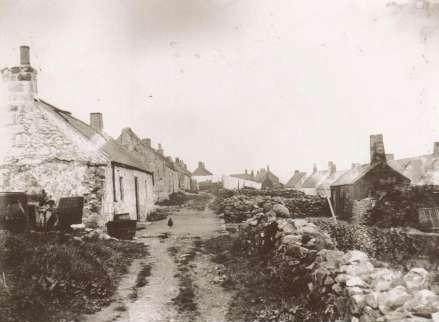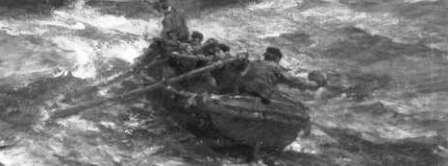
The St. Andrews Students (1710) |
One of the most amazing sea rescues that occurred in this area is also the earliest account of any rescue or shipwreck that I have listed here. I am referring to the account of seven boys that were cast adrift from the port of St. Andrews on 19th August 1710.
On that day seven boys (David Bruce, David Rankilour,
John Wilson, James Martin, Alexander Mitchell, James Thomson and James
Watson) all aged around 15, sailed out of the harbour at St. Andrews on
a small open boat for a bit of fun and recreation around the local
coast, not far from the safety of the shore. Unfortunately during their
time in the boat they lost one of their oars and were soon cast adrift
and driven out to
 sea. It was late in the day before their parents
noticed they were missing and by that time it wasn’t possible to send
out a search party. The following morning some local boats did set out
to sea in quest of the missing youths, however the search was in vain
and there was no sign of the boat or boys anywhere nearby.
sea. It was late in the day before their parents
noticed they were missing and by that time it wasn’t possible to send
out a search party. The following morning some local boats did set out
to sea in quest of the missing youths, however the search was in vain
and there was no sign of the boat or boys anywhere nearby.
They were given up as lost by the local community, however they were still very much alive and kicking, although every day “the boys were tossed up and down, without being able by their own endeavours to make any shore, though every day within sight of it”.
At length and after six days and six nights of continued labour with no food or water they eventually made it to shore, landfall being the bay at Earnsheugh near to the village of Findon – over 50 miles north of St. Andrews.
Two of the boys managed to climb the cliffs there under the direction of a local fisherman who happened to be in the area and soon they were in the care of a John Shepherd who lived nearby. Mr. Shepherd notified the Magistrates of Aberdeen of this extraordinary incident and their Dean of Guild, a physician and a surgeon rushed to the scene from where the rest of the boys made it ashore. The doctors attended to the boys however despite their best efforts the two youngest, James Martin and John Wilson, died shortly after getting ashore.
David Bruce’s father Robert, who was a goldsmith in Edinburgh, commemorated this event in a painting and an engraving, the latter representing the landing of the boys; and a portrait of one of them seated pointing to the scene. At the foot is a description in Latin and a translation of the events that had taken place. This picture was presented to the Magistrates of Aberdeen and for a period of time it hung in the council room before being “removed by order of one of the baillies, to give place to a catchpenny engraving of one of the heroes in the late war”. Latterly this engraving found its way to the library of Marischal College although no record now remains as to what happened to it.
Mr Bruce also presented Mr Shepherd with silver plate in the shape of a boat. This oval plate was about 4 inches long and had the following inscription:-
“This silver boat is gifted to John Shepherd by Robert Bruce, goldsmith, for the kindness he showed to his son David Bruce and others, after they were six days and six nights at sea without meat or drink, and by Providence, thrown in at Earn-heugh, near his house, on the 25th August 1710”.
The cliffs at Earnsheugh where the boys finally reached dry land.
